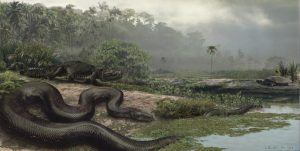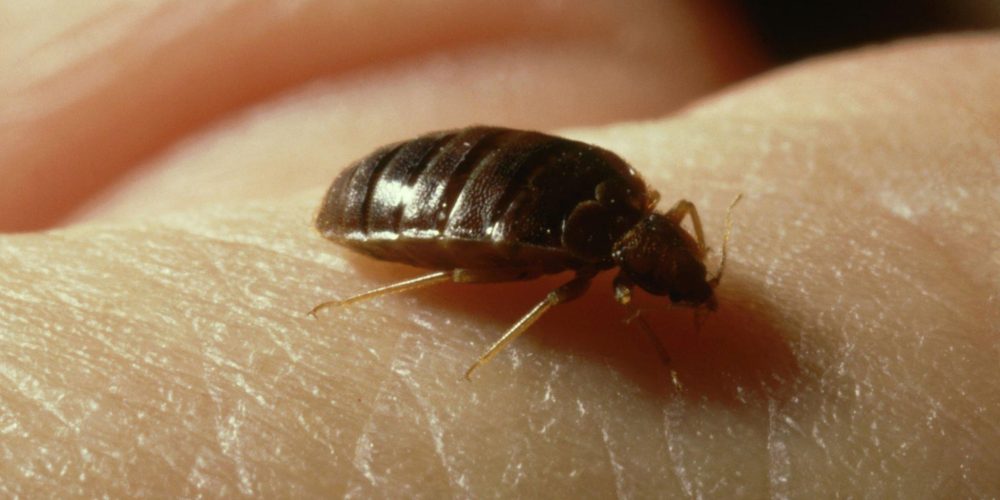Size
During the Palaeocene era reigned the world’s largest predator. Able to grow as large as 13 meters (43 feet), akin to that of a school bus. The Titanoboa was a prehistoric breed of snake that was native to present-day La Guajira in the northeast region of Colombia. The fossils of these immense creatures indicate that the Titanoboa’s rule was in the range of 58–60 million years ago in what is known as the Middle to Late Palaeocene epoch.
Though little is known about this creature, what researchers and paleontologists can tell us is that its immense size has challenged what was previously thought as the maximum size of prehistoric snakes. This discovery has resulted in the dethroning of the Gigantophis, which grew to 9 meters (30 feet) from its title of the world’s largest snake to ever exist.
Titanoboa Folklore
Though it has not been officially confirmed, it is difficult not to see the links between the Titanoboa and mythological Sachamama from Amazon folklore, which referred to a monster snake known as the Sachamama, or ‘Mother of the Rainforest.’ The Sachamama was too big to move quickly through the forest and therefore merged itself within the Earth, allowing trees, plants, and flowers to grow around it, eventually making it indistinguishable.
In this form, the giant snake could simply leave its mouth open so that hunters and other animals would wander in, never to be seen again as they walked to their death. The influence of Titanoboa is unmistakable in this account, and though its existence predated that of early man, it is easy to imagine that the fossils Titanoboa left behind would have inspired the mind’s imagination.
Natural habitat
This behemoth of the snake family was discovered after working for 7 years within the North Columbium mine, Carrejón. Carrejón, the world’s largest coal mine, is now quite a dry and arid terrain, but it once harbored a dense and swampy jungle that was hotter, wetter, and bigger than the modern Carrejón. Within this mine, wrapped into the river basin, is a window into the world of the oldest known ecosystem of a tropical rainforest.
It was within this portal into the past that Smithsonian Scientist Carlos Jaramillo found turtle shells the size of manhole covers, seven-foot lungfish, and the remains of at least 3 new different species of crocodile that were more than a dozen feet long.
It was amongst this collection of prehistoric giants that 28 fossils of the titanic reptilian rulers were discovered, the Titanoboa. This ancient monster is believed to range from 12 to 13 meters (40 – 43 feet) in size, and the highest part go the snake’s body would have reached up to the waist of an average man today! Weighing more than a ton, this swamp denizen was a fearsome predator that could consume any animal it set its sights on, making it one of the deadliest predators this Earth has ever seen. Meaning that even though the dinosaurs were not alive anymore, the Earth was still not free from the draconian reign of a giant predator.
The inconceivable size of the Titanoboa means that the creature’s remains provide an insight into the temperatures and, therefore, the atmosphere of the Earth at this point in time. Snakes, like other reptilians, rely on the heat of the air and Sun to heat their body. Therefore, Titanoboa was dependent on the environment to survive and grow in a process known as Poikilothermy. Therefore, the maximum size of poikilothermic animals at any given temperate is limited by metabolic rate.
A snake the size of the Titanoboa would require a mean temperature from 30 – 34 degrees Celsius to survive. This is in line with the general belief that the Palaeocene era was characterized with on average higher temperatures and higher levels of CO2.
Similarities with the anaconda snake
Scientists believe that the Titanoboa hunted in a similar method to present-day anacondas. By grabbing their prey near the shore and dragging it underwater, drowning it whilst the snake held the advantage, and then wrapping its body around the victim and constricting it to death. It is not preposterous to suggest that this apex predator preyed on prehistoric crocodiles and turtles as its size meant that it enjoyed an advantage. Furthermore, this snake’s long digestive process meant that only one meal would satisfy the Titanoboa for a year.
Though there were few that could prey on the Titanoboa, in its juvenile state or as an egg, it would be most vulnerable. In a twist of fate, the only predator of the Titanoboa were those prehistoric crocodiles that the giant anaconda fed on. As eggs or as a juvenile, these crocodiles could safely attack a Titanoboa. Other than this, the prehistoric crocodile struggled to match up to a fully grown version of this snake.
The Titanoboa highlights that our world’s history is more diverse and more imaginative than we give it credit for, and it reminds us that when discoveries such as the Titanoboa’s are made, what we declare as fact is not as concrete as we would prefer. If a giant snake with a size of 13 meters (43 feet) could exist, what other giants did this Earth sustain, and when will we discover them?















